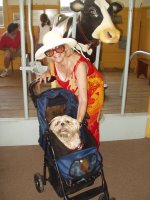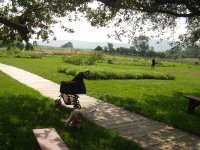

An air of peace and quiet purposefulness pervades the Hancock Shaker Village, which is not a reproduction, but a reconstruction. It used to be called the City of Peace. The ghosts who linger here are happy ghosts. Bao romped and sniffed. He’s finally getting the hang of grass.
Arriving first thing in the morning was a good idea, and not just to avoid the heat. Having the whole 1200 acres to ourselves was magical. The green fields, the gardens and the simple, sturdy buildings were like a stage setting.
Shaker communities were founded on the basis of celibacy, confession and community. The brothers and sisters of each community (at the movement’s height, there were 19 Shaker villages) lived, worked and prayed together, devoting themselves to the service of God. If it sounds a bit grim, it wasn’t. There was music, singing, dancing and laughter. Women and men were equal. And although they eschewed the two-backed beast, they did enjoy a smoke and until 1826, the occasional tipple. So celibacy doesn’t seem to have been a problem. Our guide suggested that in fact, it may have been a welcome respite for the many widows who joined the community.
Shakers were superb craftsmen, inventing both the flat-bottomed broom, the mail order business (through which they sold seeds and herbs from their gardens) and their famous, finely-crafted chairs and oval boxes, which were made to order and shipped to customers all over the United States.
Of the buildings, the Round Stone Barn is unique. 270 feet in diameter, its walls are over 20 feet high and three feet thick. Up to 400 tons of hay can be stored in the central core of the barn, while the outer perimeter of its middle level is divided into stalls for milking cows. Manure is stored in a sort of basement below. The Shakers ran a successful dairying business until new laws mandating concrete floors for milking cows made the barn’s wooden floors obsolete. That was bad luck. When Krakatoa erupted in 1873, it snowed in July and the gardens never really recovered. More bad luck.
But it was the Industrial Revolution that put paid to this 200-year old experiment in communal living. More jobs, more money, more opportunity. The last of the sisters left the City of Peace in 1960, although a Shaker community continues to function in Sabbathday, Maine.
There are still gardens, and farm animals. The cow in the photo is a replica, but you can milk it. (I didn’t. I’ve never milked a cow or jumped out of an airplane, and I don’t intend to start now) You can also card wool, try your hand at weaving and dress up in Shaker clothing and have your photo taken. Everyone took Bao’s photo. I suspect he’s this season’s most photographed dog in the Berkshires.
On to Boston.

1 Comments:
Can you imagine a trip with Bacchus and Bao? My guy gets photographed a lot too!
2:16 PM
Post a Comment
<< Home